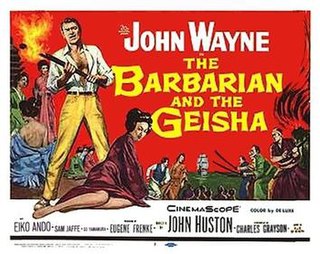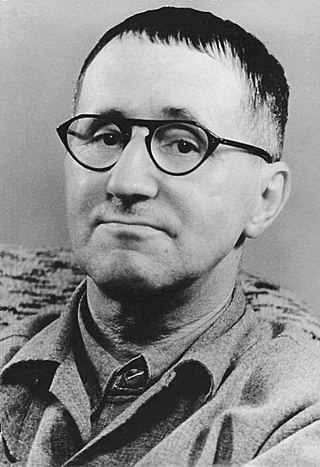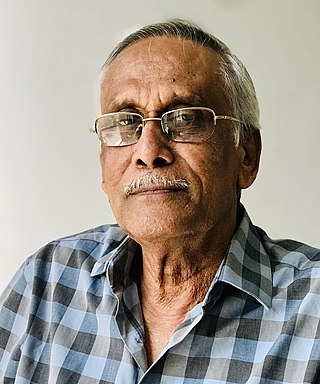Related Research Articles

Life of Galileo, also known as Galileo, is a play by the 20th century German dramatist Bertolt Brecht and collaborator Margarete Steffin with incidental music by Hanns Eisler. The play was written in 1938 and received its first theatrical production at the Zurich Schauspielhaus, opening on the 9th of September 1943. This production was directed by Leonard Steckel, with set-design by Teo Otto. The cast included Steckel himself, Karl Paryla and Wolfgang Langhoff.

Mother Courage and Her Children is a play written in 1939 by the German dramatist and poet Bertolt Brecht (1898–1956), with significant contributions from Margarete Steffin. Four theatrical productions were produced in Switzerland and Germany from 1941 to 1952, the last three supervised and/or directed by Brecht, who had returned to East Germany from the United States.

Erwin Friedrich Maximilian Piscator was a German theatre director and producer. Along with Bertolt Brecht, he was the foremost exponent of epic theatre, a form that emphasizes the socio-political content of drama, rather than its emotional manipulation of the audience or the production's formal beauty.

Yūzō Yamamoto was a Japanese novelist and playwright. His real name was written as "山本 勇造" but pronounced the same as his pen name.

Baal was the first full-length play written by the German modernist playwright Bertolt Brecht. It concerns a wastrel youth who becomes involved in several sexual affairs and at least one murder. It was written in 1918, when Brecht was a 20-year-old student at Munich University, in response to the expressionist drama The Loner by the soon-to-become-Nazi dramatist Hanns Johst.

The Barbarian and the Geisha is a 1958 American adventure film directed by John Huston and starring John Wayne. The film was shot primarily on location in Japan.

Pyynikki Summer Theatre is an open-air theatre operating in Tampere, Finland, known especially for its revolving auditorium. It is one of the largest summer theatres in Finland and has been running uninterrupted longer than any other open-air theatre in the country.
The Lehrstücke are a radical and experimental form of modernist theatre developed by Bertolt Brecht and his collaborators from the 1920s to the late 1930s. The Lehrstücke stem from Brecht's epic theatre techniques but as a core principle explore the possibilities of learning through acting, playing roles, adopting postures and attitudes etc. and hence no longer divide between actors and audience. Brecht himself translated the term as learning-play, emphasizing the aspect of learning through participation, whereas the German term could be understood as teaching-play. Reiner Steinweg goes so far as to suggest adopting a term coined by the Brazilian avant garde theatre director Zé Celso, Theatre of Discovery, as being even clearer.
Lamp At Midnight is a play that was written by Barrie Stavis, and first produced in 1947 at New Stages, New York. The play treats the 17th Century Galileo affair, which was a profound conflict between the Roman Catholic Church and Galileo Galilei over the interpretation of his astronomical observations using the newly invented telescope. By coincidence, Bertolt Brecht's play on the same theme, Life of Galileo, opened in New York just a few weeks before Lamp at Midnight. Some critics now consider Galileo to be a masterpiece, but in 1947 the New York Times reviewer, Brooks Atkinson, preferred Lamp at Midnight.
Mr Puntila and His Man Matti is an epic comedy by the German modernist playwright Bertolt Brecht. It was written in 1940 and first performed in 1948.
The Decision, frequently translated as The Measures Taken, is a Lehrstück and agitprop cantata by the twentieth-century German dramatist Bertolt Brecht. Created in collaboration with composer Hanns Eisler and director Slatan Dudow, it consists of eight sections in prose and unrhymed, free verse, with six major songs. A note to the text by all three collaborators describes it as an "attempt to use a didactic piece to make familiar an attitude of positive intervention."
Round Heads and Pointed Heads is an epic parable play written by the German dramatist Bertolt Brecht, in collaboration with Margarete Steffin, Emil Burri, Elisabeth Hauptmann, and the composer Hanns Eisler. The play's subtitle is Money Calls to Money and its authors describe it as "a tale of horror." The play is a satirical anti-Nazi parable about a fictitious country called Yahoo in which the rulers maintain their control by setting the people with round heads against those with pointed heads, thereby substituting racial relations for their antagonistic class relations. The play is composed of 11 scenes in prose and blank verse and 13 songs. Unlike another of Brecht's plays from this period, The Mother, Round Heads and Pointed Heads was addressed to a wide audience, Brecht suggested, and took account of "purely entertainment considerations." Brecht's notes on the play, written in 1936, contain the earliest theoretical application of his "defamiliarization" principle to his own "non-Aristotelian" drama.
Antigone, also known as The Antigone of Sophocles, is an adaptation by the German dramatist Bertolt Brecht of Hölderlin's translation of Sophocles' tragedy. It was first performed at the Chur Stadttheater in Switzerland in 1948, with Brecht's second wife Helene Weigel, in the lead role. This was Brecht's first directorial collaboration with Caspar Neher.
Coriolanus is an unfinished German adaptation by the modernist playwright Bertolt Brecht of the English 17th-century tragedy of the same name by William Shakespeare. Brecht wrote it sometime between 1951 and 1953. This adaptation reveals the influence of Mao Zedong on Brecht's social thought especially the idea of primary and secondary contradictions which Mao discussed in his treatise On Contradiction. Brecht alluded to this text and discusses his development on the original and his ideas for its staging in an essay entitled "Study of the First Scene of Shakespeare's Coriolanus", which is written in the form of a dialogue with his collaborators at the Berliner Ensemble theatre company. The play was first staged by Heinrich Koch at the Frankfurt Schauspielhaus theatre, where it opened on 22 September 1962. It was later staged by the Berliner Ensemble in September 1964. Ruth Berghaus became famous for her staging of the battle scenes in this production. The play was published in an English translation by Ralph Manheim in volume nine of Brecht's Collected Plays.
Turandot or the Whitewashers' Congress is an epic comedy by the German modernist playwright Bertolt Brecht. It was written during the summer of 1953 in Buckow and substantially revised in light of a brief period of rehearsals in 1954, though it was still incomplete at the time of Brecht's death in 1956 and did not receive its first production until several years later. It premièred on 5 February 1969 at the Zürich Schauspielhaus, in a production directed by Benno Besson and Horst Sagert, with music by Yehoshua Lakner.
Downfall of the Egotist Johann Fatzer is an unfinished play by Bertolt Brecht, written between 1926 and 1930. Translated as Downfall of the Egotist Johann Fatzer or Demise of the Egotist Johann Fatzer, the play is often called the Fatzer Fragment, or simply Fatzer.
The Good Person of Szechwan is a play written by the German dramatist Bertolt Brecht, in collaboration with Margarete Steffin and Ruth Berlau. The play was begun in 1938 but not completed until 1941, while the author was in exile in the United States. It was first performed in 1943 at the Zürich Schauspielhaus in Switzerland, with a musical score and songs by Swiss composer Huldreich Georg Früh. Today, Paul Dessau's composition of the songs from 1947 to 1948, also authorized by Brecht, is the better-known version. The play is an example of Brecht's "non-Aristotelian drama", a dramatic form intended to be staged with the methods of epic theatre. The play is a parable set in the Chinese "city of Sichuan".

Eugen Berthold Friedrich Brecht, known professionally as Bertolt Brecht, was a German theatre practitioner, playwright, and poet. Coming of age during the Weimar Republic, he had his first successes as a playwright in Munich and moved to Berlin in 1924, where he wrote The Threepenny Opera with Kurt Weill and began a life-long collaboration with the composer Hanns Eisler. Immersed in Marxist thought during this period, he wrote didactic Lehrstücke and became a leading theoretician of epic theatre and the Verfremdungseffekt.
Koreya Senda was a Japanese stage director, translator, and actor. He was born in Kanagawa Prefecture. He is known mostly for founding the Haiyūza theatre company, and translating and directing the works of Bertolt Brecht in post-World War II Japan. He appeared in more than 50 films between 1936 and 1970.

Abdus Selim is a Bangladeshi academic, writer and translator. He was awarded Bangla Academy Literary Award in 2015 in the translation category and Shaheed Muneir Chowdhury Award in 2010 for his contribution to theatre. He is currently a faculty member of the Department of English Language-Literature at Central Women's University.
References
- ↑ Bertolt Brecht: Die Judith von Shimoda. Nach einem Stück von Yamamoto Yuzo. In Collaboration with Hella Wuolijoki. Reconstruction of a playscript by Hans Peter Neureuter. Suhrkamp: Frankfurt am Main, 2006. ISBN 978-3-518-12470-3.
- ↑ Brecht and the Writer's Workshop: Fatzer and Other Dramatic Projects. Edited by Tom Kuhn and Charlotte Ryland. London: Bloomsbury Methuen Drama, 2019, pages 293-372. ISBN 978-1-4742-7328-2.
- ↑ Dennis Carroll. "Wuolijoki, Brecht, 'Well Made' Dramaturgy, and The Judith of Shimoda." The Brecht Yearbook 36: Brecht in/and Asia. University of Wisconsin Press, 2011. pages 328-335, here 334.
- ↑ Scott Horton. "A Brecht Premiere." Harper's Magazine September 2008.
- ↑ Joseph T. Rozmiarek. "'Judith' a Coup for UH, a Window into Playwright." Honolulu Advertiser, May 5, 2010.
- ↑ Stephen Brockmann. Review of The Judith of Shimoda. Communications from the International Brecht Society 39 (2010). pages 76-81, here 80.